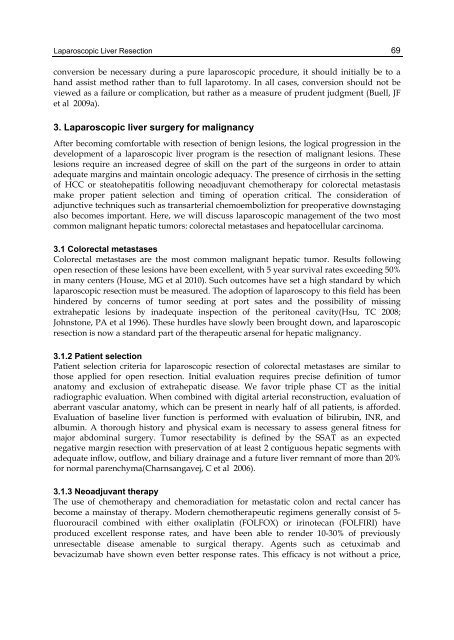UPDATED TOPICS IN MINIMALLY INVASIVE ABDOMINAL SURGERY
UPDATED TOPICS IN MINIMALLY INVASIVE ABDOMINAL SURGERY
UPDATED TOPICS IN MINIMALLY INVASIVE ABDOMINAL SURGERY
You also want an ePaper? Increase the reach of your titles
YUMPU automatically turns print PDFs into web optimized ePapers that Google loves.
Laparoscopic Liver Resection<br />
conversion be necessary during a pure laparoscopic procedure, it should initially be to a<br />
hand assist method rather than to full laparotomy. In all cases, conversion should not be<br />
viewed as a failure or complication, but rather as a measure of prudent judgment (Buell, JF<br />
et al 2009a).<br />
3. Laparoscopic liver surgery for malignancy<br />
After becoming comfortable with resection of benign lesions, the logical progression in the<br />
development of a laparoscopic liver program is the resection of malignant lesions. These<br />
lesions require an increased degree of skill on the part of the surgeons in order to attain<br />
adequate margins and maintain oncologic adequacy. The presence of cirrhosis in the setting<br />
of HCC or steatohepatitis following neoadjuvant chemotherapy for colorectal metastasis<br />
make proper patient selection and timing of operation critical. The consideration of<br />
adjunctive techniques such as transarterial chemoemboliztion for preoperative downstaging<br />
also becomes important. Here, we will discuss laparoscopic management of the two most<br />
common malignant hepatic tumors: colorectal metastases and hepatocellular carcinoma.<br />
3.1 Colorectal metastases<br />
Colorectal metastases are the most common malignant hepatic tumor. Results following<br />
open resection of these lesions have been excellent, with 5 year survival rates exceeding 50%<br />
in many centers (House, MG et al 2010). Such outcomes have set a high standard by which<br />
laparoscopic resection must be measured. The adoption of laparoscopy to this field has been<br />
hindered by concerns of tumor seeding at port sates and the possibility of missing<br />
extrahepatic lesions by inadequate inspection of the peritoneal cavity(Hsu, TC 2008;<br />
Johnstone, PA et al 1996). These hurdles have slowly been brought down, and laparoscopic<br />
resection is now a standard part of the therapeutic arsenal for hepatic malignancy.<br />
3.1.2 Patient selection<br />
Patient selection criteria for laparoscopic resection of colorectal metastases are similar to<br />
those applied for open resection. Initial evaluation requires precise definition of tumor<br />
anatomy and exclusion of extrahepatic disease. We favor triple phase CT as the initial<br />
radiographic evaluation. When combined with digital arterial reconstruction, evaluation of<br />
aberrant vascular anatomy, which can be present in nearly half of all patients, is afforded.<br />
Evaluation of baseline liver function is performed with evaluation of bilirubin, <strong>IN</strong>R, and<br />
albumin. A thorough history and physical exam is necessary to assess general fitness for<br />
major abdominal surgery. Tumor resectability is defined by the SSAT as an expected<br />
negative margin resection with preservation of at least 2 contiguous hepatic segments with<br />
adequate inflow, outflow, and biliary drainage and a future liver remnant of more than 20%<br />
for normal parenchyma(Charnsangavej, C et al 2006).<br />
3.1.3 Neoadjuvant therapy<br />
The use of chemotherapy and chemoradiation for metastatic colon and rectal cancer has<br />
become a mainstay of therapy. Modern chemotherapeutic regimens generally consist of 5fluorouracil<br />
combined with either oxaliplatin (FOLFOX) or irinotecan (FOLFIRI) have<br />
produced excellent response rates, and have been able to render 10-30% of previously<br />
unresectable disease amenable to surgical therapy. Agents such as cetuximab and<br />
bevacizumab have shown even better response rates. This efficacy is not without a price,<br />
69














![focuspdca.ppt [Compatibility Mode]](https://img.yumpu.com/22859457/1/190x146/focuspdcappt-compatibility-mode.jpg?quality=85)


